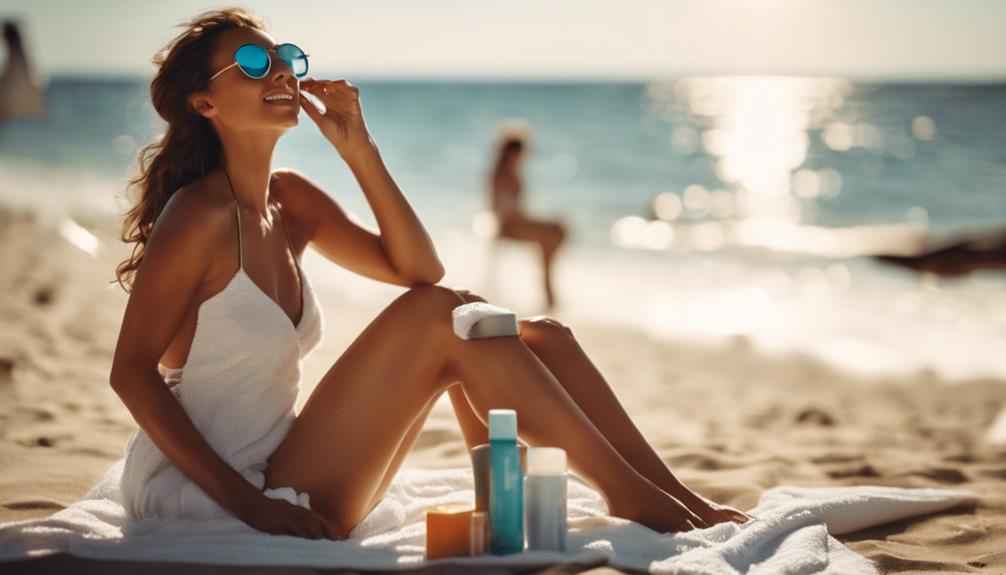To reveal the secret to tanned feet, you'll want to maximize sun exposure and choose the right footwear. Open-toed sandals or flip-flops are your best bet for getting those rays. Aim for peak sun hours and rotate your feet to guarantee even tanning. Don't forget to exfoliate before applying any self-tanner and use a good moisturizer to avoid dark patches. Always apply broad-spectrum sunscreen to protect your skin and reapply regularly. With the right techniques, you can achieve that even tan you desire. Curious about more insider tips? There's much more to explore!
Key Takeaways
- Choose open-toed sandals or flip-flops to maximize sun exposure on your feet for effective tanning.
- Exfoliate and moisturize your feet before tanning to ensure an even and smooth application.
- Apply broad-spectrum sunscreen generously to protect your feet from burning while tanning.
- Rotate your feet regularly during sun exposure to achieve a uniform tan across all angles.
Factors Influencing Tanning
When it comes to tanning, several key factors like melanin levels, skin thickness, and blood circulation play an essential role in how well your skin darkens under the sun.
If you have higher melanin levels, you'll likely tan faster, while those with lower levels might burn before seeing any color.
Skin thickness also matters; thicker skin absorbs UV rays less efficiently, making it harder for certain areas, like your feet, to tan. You'll notice uneven tanning in spots where the skin is thinner.
Additionally, good blood circulation is fundamental for even tanning, as it delivers nutrients to your skin. Regular exercise can help improve circulation, supporting your tanning efforts and promoting a more uniform glow.
Choosing the Right Footwear
Choosing the right footwear can greatly enhance your tanning potential by allowing more sun exposure to your feet and toes. Opt for open-toed sandals or flip-flops that keep your feet exposed to sunlight, maximizing your tanning opportunities. Avoid closed-toe shoes, as they block sunlight and hinder tanning progress.
Also, consider the materials of your footwear; breathable fabrics like canvas allow more airflow and reduce sweat buildup, preventing uneven tanning. Verify your shoes fit comfortably; tight footwear can cause friction and patchy tans.
Best Tanning Techniques

Utilizing effective tanning techniques can greatly enhance your results and help you achieve a more even, radiant tan.
First, maximize your exposure time by soaking up the sun during peak hours, typically between 10 AM and 4 PM. Rotate your feet to guarantee all angles get equal sunlight.
If you're using self-tanner, exfoliate your skin beforehand for a smoother application. Apply moisturizer on rough spots like ankles and toes to prevent unevenness. Use a tanning mitt for better control and blending.
Finally, don't forget to check your footwear; choose open-toed options to allow sunlight on your feet.
Sunscreen Application Essentials
Proper sunscreen application is essential for protecting your skin and achieving an even tan without the risk of burns.
You should apply a generous amount of broad-spectrum sunscreen with at least SPF 30 to all exposed areas, including your feet. Don't forget those often-neglected spots like the tops of your feet and between your toes.
Reapply every two hours, or more often if you're sweating or swimming. For the best results, use sunscreen about 15-30 minutes before sun exposure to allow it to absorb.
Rotate your feet to guarantee even coverage and maximize sun exposure. Remember, a consistent application routine helps maintain skin health while allowing you to achieve that beautiful tan you desire.
Self-Tanning for Even Color

Achieving an even tan can be challenging, but self-tanning offers an effective solution for those looking to enhance their skin color without the risks associated with sun exposure.
To start, exfoliate your feet thoroughly to remove dead skin cells, ensuring a smooth canvas.
Next, moisturize your ankles and toes lightly to prevent dark patches.
When applying self-tanner, use a tanning mitt for a controlled and even application, focusing on blending around tricky areas like your ankle bones.
For best results, apply self-tanner in circular motions, which helps achieve a seamless look.
Finally, allow the tan to dry completely before putting on socks or shoes to avoid smudging.
Embrace these tips for beautifully tanned feet!
Addressing Uneven Tanning Issues
To effectively address uneven tanning issues, start by exfoliating your skin to create a smooth base for an even tan.
Focus on your feet and hands, as these areas often suffer from patchy color.
Apply a non-oil-based moisturizer to dry spots before tanning; this helps the self-tanner blend better.
When applying self-tanner, prioritize your feet and hands last to achieve a more uniform look.
Use a tanning mitt and work in circular motions, especially around tricky areas like your ankle bones.
If you notice stubborn patches, use a gentle scrub or lemon juice to lighten them.
With these tips, you can achieve a beautifully even tan that enhances your overall look.
Trending Tanning Topics

As tanning techniques evolve, staying updated on trending topics can help you maximize your results while ensuring safety and effectiveness. Here are some of the current trends shaping the tanning world:
| Trending Topics | Why They Matter |
|---|---|
| Tanning Bed Hygiene | Prevents skin infections and promotes safety |
| Best Tanning Bed Goggles | Protects your eyes from harmful UV rays |
| Pre-Tanning Skin Prep | Enhances tanning results and skin health |
| Tanning Bed Face Covers | Shields sensitive facial skin from burns |
| Safety Tips for Tanning Beds | Reduces risks associated with indoor tanning |
Frequently Asked Questions
How Does Diet Impact Skin Tanning Results?
Your diet plays an essential role in skin tanning results. Consuming foods rich in carotenoids, vitamins, and antioxidants enhances melanin production, promoting a deeper tan. Hydrating well also keeps your skin healthy and radiant.
Can Hydration Levels Affect Tanning Effectiveness?
Hydration's like a sunbeam—without it, your skin struggles to absorb that golden glow. When you're well-hydrated, your skin retains moisture, promoting better tanning results. So, keep sipping water for a radiant, sun-kissed appearance!
What Role Does Genetics Play in Tanning Ability?
Genetics greatly influences your tanning ability. If you have higher melanin levels, you'll tan more easily. Conversely, lower melanin means you might burn before achieving that desired tan, affecting your overall tanning experience.
Are There Specific Vitamins That Enhance Skin Tanning?
Certain vitamins, like A, C, and E, support skin health and may enhance tanning. They help boost collagen production and protect against sun damage, so consider incorporating these nutrients into your diet for better tanning results.
How Does Age Influence the Tanning Process?
Did you know that skin's melanin production decreases with age? As you get older, tanning becomes slower and less intense, requiring you to adapt your methods for achieving an even, sun-kissed look effectively.
Conclusion
Now that you've revealed the secrets to beautifully tanned feet, you can confidently step into summer!
Remember, it's not just about the sun—your choice of footwear can make or break your tan.
And while some swear by coconut oil for a deeper glow, the truth is, moderation is key.
With the right techniques and care, you can achieve that perfect, even tan.
So, go ahead, flaunt those gorgeous feet, and enjoy every moment in the sun!









